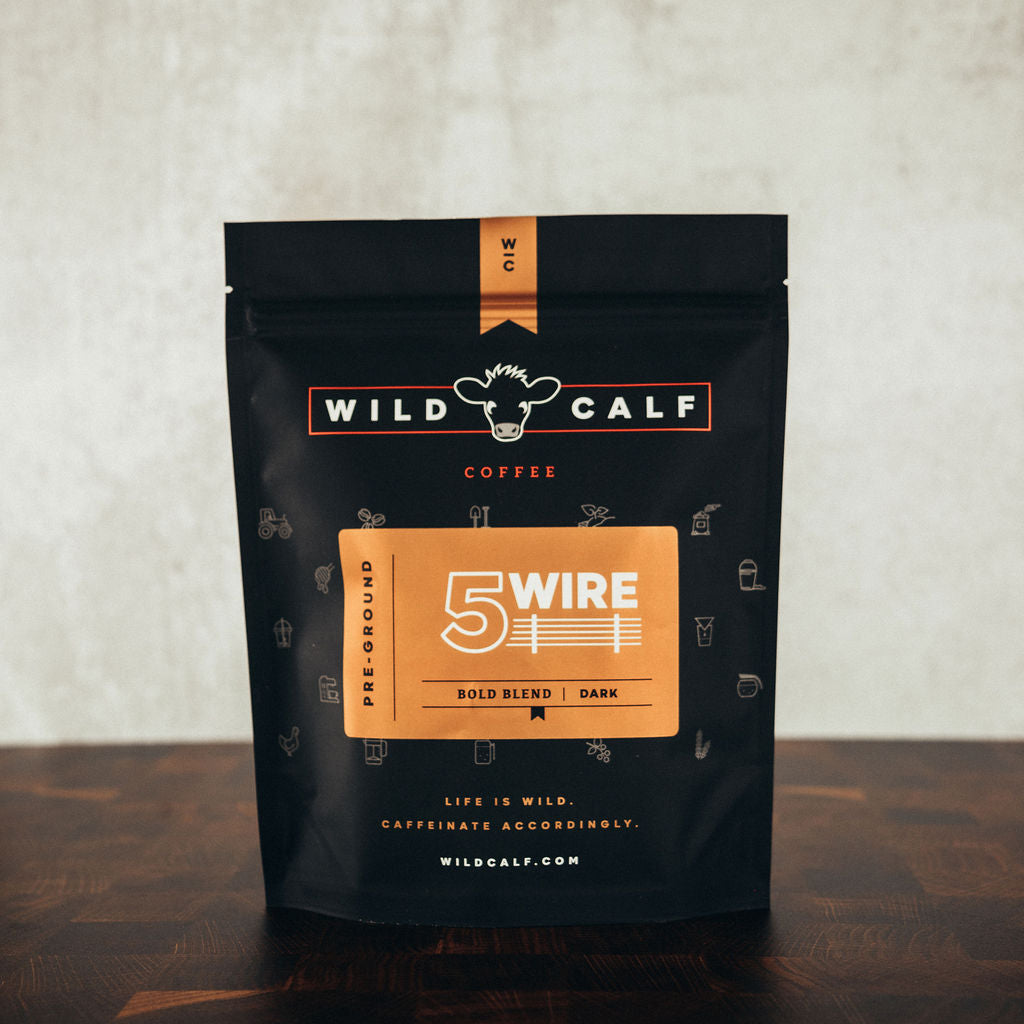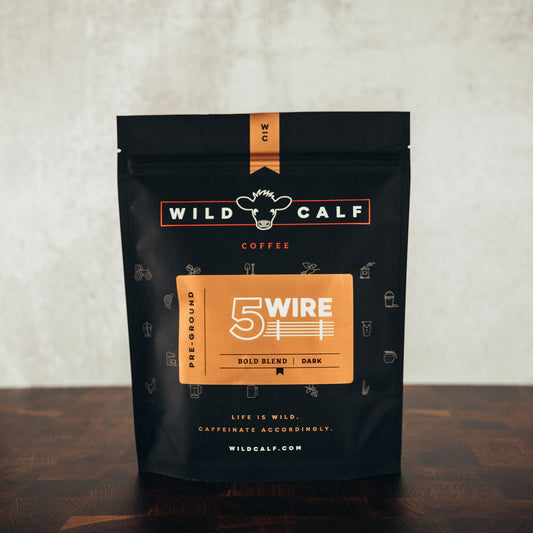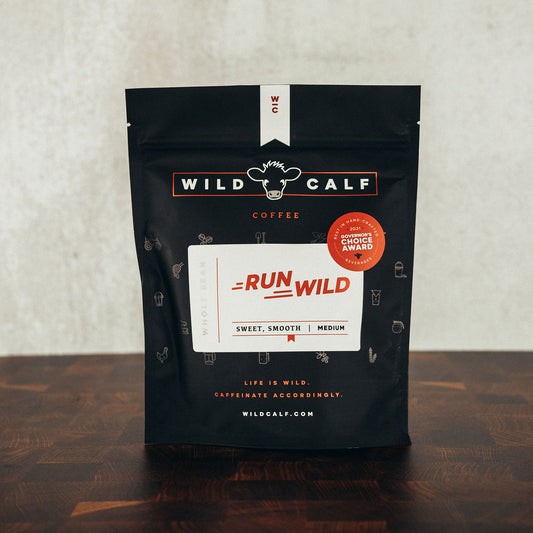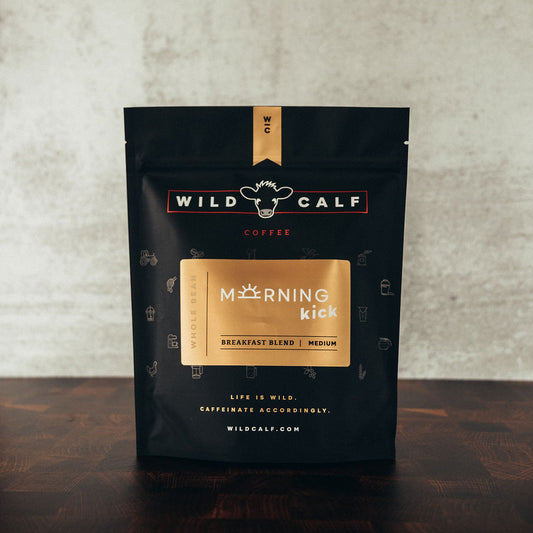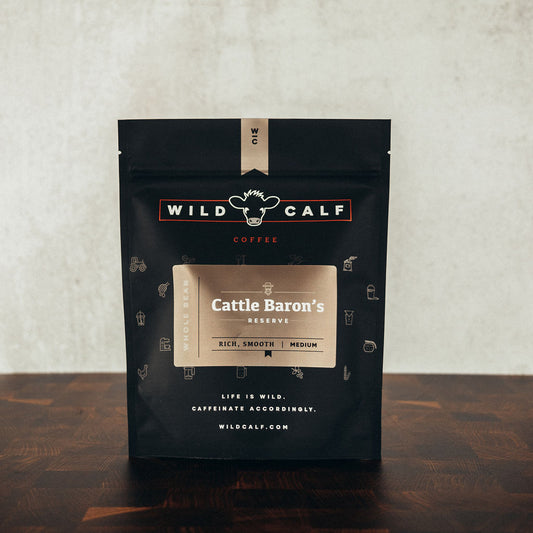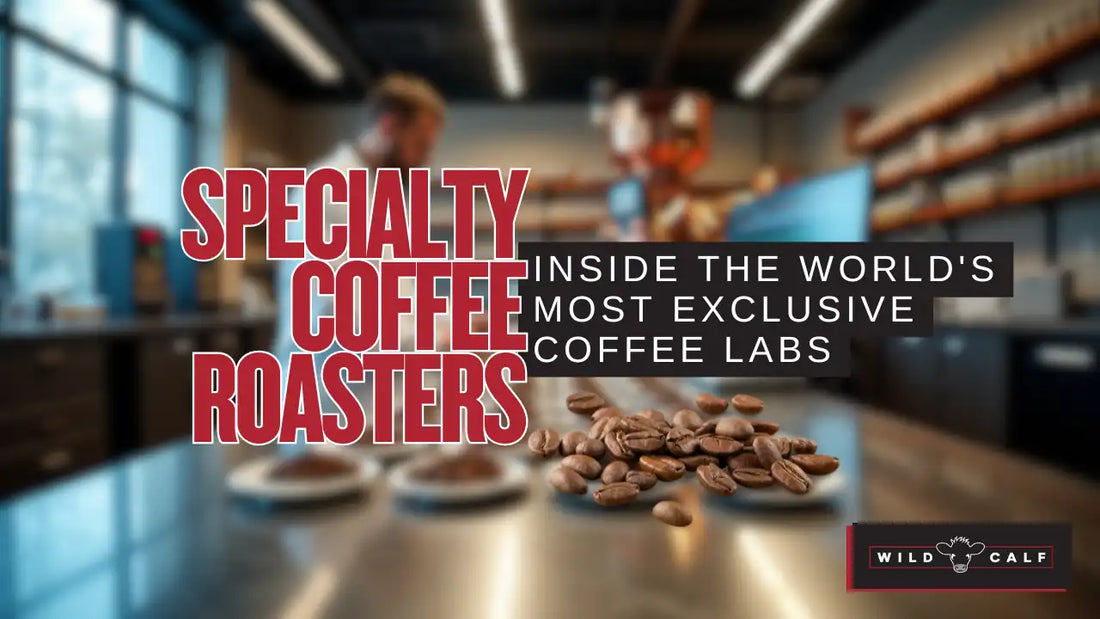
Specialty Coffee Roasters: Inside the World's Most Exclusive Coffee Labs
Specialty coffee roasters are revolutionizing our coffee experience, with over 2,167 exceptional brews scoring 94 points or higher in industry rankings. Coffee isn't just coffee anymore. Modern specialty roasting has transformed into a sophisticated craft. Expert panels reviewed over 300 roasters for the Top 100 rankings of 2024 and found a fascinating world where scientific precision meets artistic mastery.
These sophisticated coffee laboratories showcase master roasters who combine state-of-the-art equipment with refined techniques to perfect every batch. Their facilities blend science and craftsmanship in the interests of the perfect cup, using temperature-controlled environments and advanced moisture monitoring systems.
In this blog, Wild Calf Coffee will take you inside these high-tech coffee sanctuaries, uncover the secrets of top-tier specialty roasters, and explore the meticulous process that transforms raw beans into award-winning cups of coffee. Get ready to discover the science, craftsmanship, and dedication behind every sip.
Inside Top Specialty Coffee Labs
Modern specialty coffee labs showcase precision and innovation. These advanced facilities contain specialized equipment that helps realize the full potential of every coffee bean.
Lab Equipment and Technology
Top specialty coffee labs use advanced analytical equipment to maintain consistent quality. Digital moisture meters analyze both green and parchment coffee and give instant readings through backlit displays. The labs also use sophisticated moisture and density meters to measure everything from cherry to roasted coffee beans.
Color analysis is a vital part of quality assessment. Labs use roast color analyzers to measure and classify roasting degrees with precision. The new CM-200 analyzers give a full picture of both whole beans and ground coffee for roast uniformity.
Quality control teams work with dual-layer touchscreen interfaces that are easy-to-use and help manage profiles. These interfaces can handle tough roasting environments and give precise control over key parameters.
Quality Control Processes
Labs follow detailed protocols that start with physical analysis of green coffee. Quality control specialists look for color uniformity, size consistency, and possible defects. Industry standards require that specialty green beans have no more than 5 full defects in 350 grams of coffee.
Teams test moisture activity next, where readings between 0.50-0.55 show optimal conditions. They then check moisture content to make sure levels stay within the ideal 10-12% range for specialty coffee.
Temperature monitoring systems help maintain consistency. Advanced sensors provide live data and adjust automatically to keep roasting environments at optimal levels. These systems combine radiation, convection, and conduction heat sources for even distribution throughout the roasting chamber.
Sample Roasting Stations
Sample roasting stations are the foundations of quality assessment in specialty coffee labs. These special areas usually have small-batch roasters that handle 100-gram samples and allow precise evaluation of coffee characteristics.
Specialists must focus completely on the sample roasting process. They carefully adjust variables like airflow and temperature. This hands-on method helps beans develop their best characteristics before cupping sessions.
New sample roasters include data collection systems that track key information. They monitor green coffee weight, roasted coffee weight, temperature curves, and total roast time. This detailed record helps roasters analyze and improve their techniques.
Labs typically roast five similar samples of each coffee batch to get a complete quality assessment. This method helps spot any inconsistencies in the roasting process. The advanced software also lets roasters save and recall multiple profiles, which makes it easy to repeat successful roasts.
These sophisticated processes and equipment help specialty coffee labs maintain high standards in premium coffee production. Their steadfast dedication to precision and quality control meets the highest industry standards for excellence.
How Master Roasters Perfect Their Craft
Becoming skilled at coffee roasting takes years of dedicated training and expertise. Expert roasters spend countless hours learning to 'read' beans and make split-second roasting decisions.
Cupping Techniques
Professional roasters use systematic cupping protocols to review coffee quality. They start by grinding beans to a consistent medium-coarse texture and check the dry aroma. Hot water goes over the grounds, and roasters break the crust on the surface to analyze the released aromatics.
Specialists cup multiple samples of each coffee on different days to get accurate results. This full picture helps them spot subtle flavor variations and potential defects. Experienced roasters always cup blindly, and they often use black-interior bowls to minimize visual bias from different roast levels.
Roast Profile Development
Roast profiles are the foundations of guiding beans through precise temperature and time combinations. These profiles affect the final flavor characteristics by a lot, as different beans just need specific approaches based on their density and variety.
Master roasters look at several key factors during profile development:
- Bean density and hardness determine original charge temperature - lower density beans just need reduced starting heat to prevent over-roasting
- Variety shapes affect roasting approach - rounded beans roast more evenly than elongated or pointed varieties
- Processing methods affect profile adjustments - natural processed coffees contain more residual sugars requiring careful heat management
The Rate of Rise (RoR) is a vital part in profile development. Skilled roasters analyze RoR data plotted on roast graphs to make timely adjustments and maintain consistent profiles. This controlled approach will give a balanced and vibrant flavor.
Roasters track how beans respond during critical stages:
- Original temperature drop (70-90 seconds)
- Rapid heat increase phase
- First crack development
- Final development time (typically 30-45 seconds)
Master roasters focus on achieving smooth, controlled temperature curves instead of following rigid formulas. They fine-tune other variables like development time ratio and bean temperature targets only after mastering simple profile control.
Specialty roasters keep detailed logs of each roast, recording parameters such as:
- Bean origin and batch size
- Temperature curves and total roast time
- Resulting flavors and characteristics
This systematic documentation helps them refine techniques and consistently reproduce successful profiles. Coffee beans naturally change over time, so roasters must regularly review and adjust their approaches to maintain optimal results.
The Science Behind Specialty Coffee Roasting
"Without my morning coffee I'm just like a dried up piece of roast goat." — Johann Sebastian Bach, Renowned Baroque composer
A complex mix of chemical reactions and precise scientific controls creates every exceptional cup of specialty coffee. Master roasters use sophisticated technology to tap into each bean's full potential in these advanced roasting facilities.
Temperature Control Systems
Modern roasting operations rely on advanced PID (Proportional, Integral, Derivative) controllers. These systems track bean temperature against desired setpoints and automatically adjust burner levels to maintain optimal roasting conditions. PID controllers make multiple calculations every second to ensure smooth temperature curves that create consistent flavor.
Bean Moisture Monitoring
Original moisture content greatly affects roasting outcomes. Green coffee beans usually contain 10-12% moisture, which helps distribute heat and develop flavor. Specialty roasters watch these levels closely because beans with moisture above 12% could develop mold, while those below 10% often produce flat, lifeless cups.
Chemical Changes During Roasting
Beans undergo many chemical transformations simultaneously when heated:
- The Maillard reaction starts around 150°C and creates melanoidins that add color and mouthfeel
- Sucrose breaks down quickly in early roasting stages and generates compounds like carboxylic acids, furans, and aldehydes
- Chlorogenic acids turn into caffeic and quinic acids that influence bitterness and astringency
Flavor Development Stages
Distinct yet overlapping phases shape the final flavor profile during roasting:
The drying phase removes excess moisture and starts crucial chemical reactions. This stage builds momentum for flavor development, though its main focus is moisture reduction.
Caramelization happens between 300°F and first crack (385-395°F). Sugars break down and transform during this time, which directly affects body and sweetness.
The development phase begins at first crack with quick chemical reactions that determine acidity and aromatic complexity. This phase's timing significantly affects the final flavor balance. Shorter times usually create more sweetness and acidity, while longer periods produce more caramelized notes.
Master roasters need precise control over these stages because small changes in temperature or timing can dramatically change the cup profile. To name just one example, longer Maillard reaction phases increase viscosity but might sacrifice bright, fruity notes.
Specialty coffee roasters create unique flavor profiles and maintain batch consistency by carefully controlling these scientific principles. Their deep knowledge of bean chemistry combined with advanced monitoring systems helps each roast reach its full potential.
Read our blog on Ultimate Guide to Specialty Coffee Trends and Tips in 2024 .
Quality Testing in Specialty Coffee
Quality assessment is the life-blood of specialty coffee production. Roasters use strict testing protocols and standard evaluation methods to ensure each batch meets exceptional quality standards.
Grading Systems
The Specialty Coffee Association (SCA) uses a complete 100-point scoring system to assess multiple aspects of coffee quality. Beans must score 80 points or above on this scale to qualify as specialty grade. The grading starts with a 350-gram sample of green coffee beans that goes through detailed inspection for defects.
The grading criteria covers these key attributes:
- Fragrance and aroma
- Flavor characteristics
- Acidity balance
- Body and mouthfeel
- Overall cup quality
Defect Analysis
Finding defects needs a sharp eye for detail. Quality control specialists look for both primary and secondary defects. Primary defects will immediately disqualify coffee from specialty status - black beans, sour beans, and fungus damage fall into this category. Secondary defects can still affect overall quality, though less severely. These include partial discoloration, broken beans, and minor insect damage.
Color analysis plays a vital role in spotting defects. Modern labs use specialized analyzers like the Lighttells CM-200 to measure both internal and external roast color values. This two-way measurement helps spot potential roasting issues that could change flavor development.
Taste Evaluation Methods
Professional cuppers stick to standard protocols to keep evaluations consistent across samples. They start by checking the coffee's dry fragrance, then analyze the wet aroma after adding hot water. The process moves through careful analysis of:
- Initial flavor impact
- Acidity characteristics
- Sweetness levels
- Body development
- Aftertaste qualities
Blind cupping sessions remove potential bias, which leads to objective assessment of each coffee's qualities. Quality control teams usually include several trained professionals who adjust their findings together for accuracy.
Temperature monitoring throughout the cupping process is significant because different flavor compounds show up at various temperatures. Experienced cuppers check samples at multiple points as the coffee cools and document how flavors change over time.
New developments in quality assessment now include immediate data analytics. These tools help roasters track consistency between batches and find areas they can improve. By keeping detailed cupping notes, roasters can link specific flavor attributes to certain points in the roast profile and make precise adjustments for the best results.
Innovation in Modern Coffee Labs
"A mathematician is a device for turning coffee into theorems." — Paul Erdos, Renowned mathematician
Modern coffee labs now use state-of-the-art equipment that brings remarkable precision to coffee roasting. Roasters can maintain consistent quality even with larger batches thanks to these advances.
AI-Powered Roasting
AI systems have transformed roasting consistency by monitoring key parameters. These systems track temperature, airflow, and drum speed during each roast. The system automatically adjusts variables when it detects any deviation from the ideal roasting curves.
IMF roasters showcase this technical progress with 12 preset inlet temperature points and full control of air and drum speeds. AI uses machine learning to analyze bean density, origin, and processing methods. This creates the best possible roast profiles.
Sound technology adds another layer of precision. Special microphones catch first crack sounds and make exact adjustments based on pop frequencies that human ears can't catch. This helps maintain the same quality in every batch.
Data Analytics Tools
Today's coffee labs use advanced systems to capture vital production data. IMF software monitors several factors:
- Green and roasted coffee weights
- Temperature variations
- Total roast duration
- Up-to-the-minute production logs
Smart inventory systems keep track of green coffee levels in storage silos. They alert roasters automatically when stocks run low. This keeps operations smooth and prevents any production stops.
Stronghold's data platform excels by offering detailed analysis of every roast. Roasters study previous batches and make better decisions to perfect their techniques.
Waste Reduction Practices
Coffee labs focus on environmentally responsible waste management. New roasting equipment maintains high performance while using less power.
IoT-enabled sensors help cut waste by:
- Monitoring resource usage patterns
- Optimizing energy distribution
- Identifying efficiency opportunities
Many facilities now run carbon-neutral operations through:
- Tree planting initiatives
- Renewable energy investments
- Eco-friendly equipment upgrades
The Waste Lab partnership shows innovative ways to handle coffee waste. Their method includes:
- Collecting discarded coffee grounds
- Transporting to control stations
- Purifying and processing materials
- Converting waste into soil nutrients
These environmentally responsible methods improve operations and help maintain high quality standards while reducing environmental impact.
Conclusion
Specialty coffee roasting blends artistry with technology beautifully. Modern coffee labs now use AI-powered systems and precise monitoring tools that help master roasters create consistent batches. While machines and technology make a difference, nothing beats human expertise. Master roasters' refined palates and scientific knowledge work together to craft outstanding coffee experiences.
Strict quality control defines specialty coffee standards. Each batch goes through detailed grading systems and defect analysis. On top of that, environmentally responsible practices and waste reduction show how today's facilities balance quality with sustainability.
Specialty coffee's future shines bright as state-of-the-art tools shape the industry. Master roasters challenge traditional methods with new techniques while honoring their craft's artisanal heritage. Their commitment to both old-world wisdom and new technology creates exceptional coffee that delights coffee enthusiasts around the globe.
FAQs
Q1. How many specialty coffee roasters are there in the United States?
There are over 3,000 specialty coffee roasters currently operating across the United States. This number has grown significantly in recent years as consumer interest in high-quality, artisanal coffee has increased.
Q2. What equipment is typically found in a specialty coffee lab?
Specialty coffee labs are equipped with advanced analytical tools like digital moisture meters, color analyzers, sample roasters, and temperature monitoring systems. They also have cupping stations for flavor evaluation and data collection software to track roasting parameters.
Q3. How do master roasters develop their roast profiles?
Master roasters develop roast profiles by carefully controlling variables like temperature curves, airflow, and development time. They consider factors such as bean density, variety, and processing method to create profiles that highlight each coffee's unique characteristics. Roasters use data analytics and cupping sessions to continuously refine their techniques.
Q4. What innovations are shaping modern coffee roasting?
Recent innovations in coffee roasting include AI-powered systems that autonomously adjust roasting parameters, advanced data analytics tools for quality control, and sustainable practices like energy-efficient equipment and waste reduction initiatives. Some facilities are also implementing IoT sensors and carbon-neutral operations.
Q5. How is specialty coffee evaluated for quality?
Specialty coffee undergoes rigorous quality assessment using standardized protocols. This includes physical inspection of green beans, moisture content analysis, and systematic cupping evaluations. Professional graders use a 100-point scoring system to evaluate attributes like aroma, flavor, acidity, body, and overall cup quality. Coffees must score 80 points or higher to be considered specialty grade.
